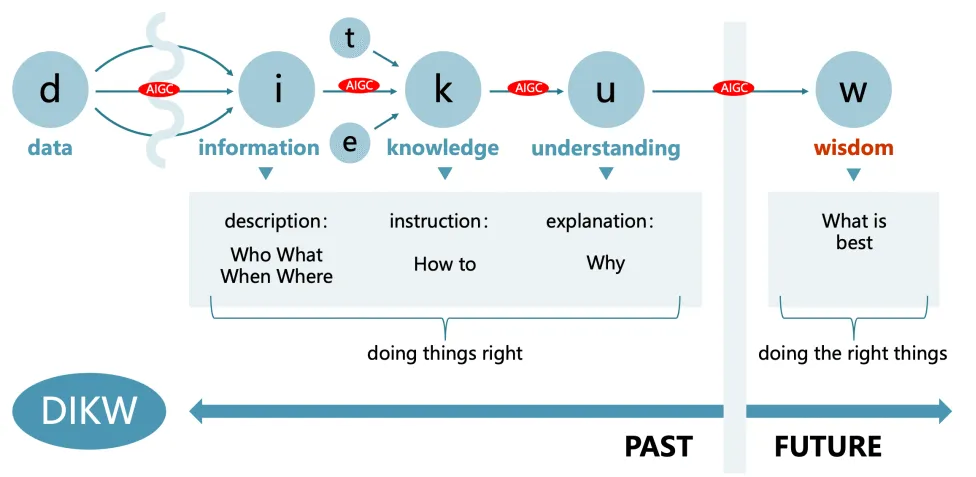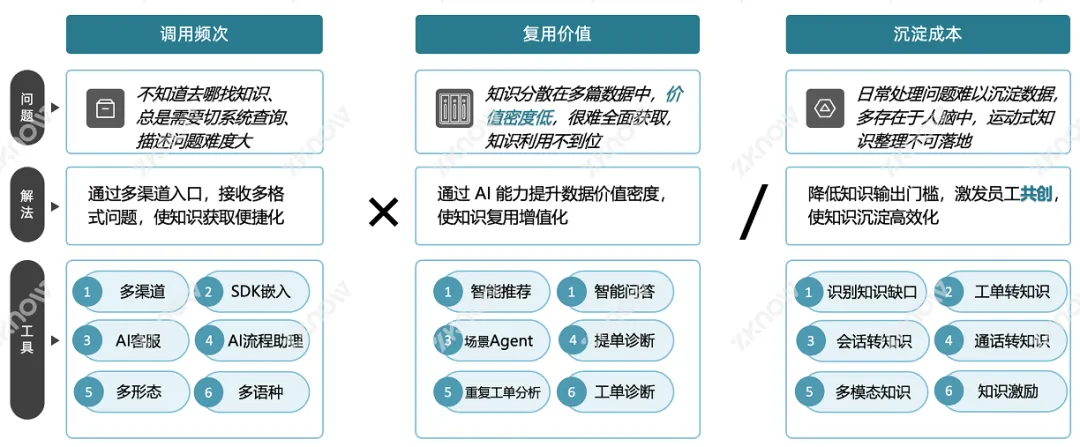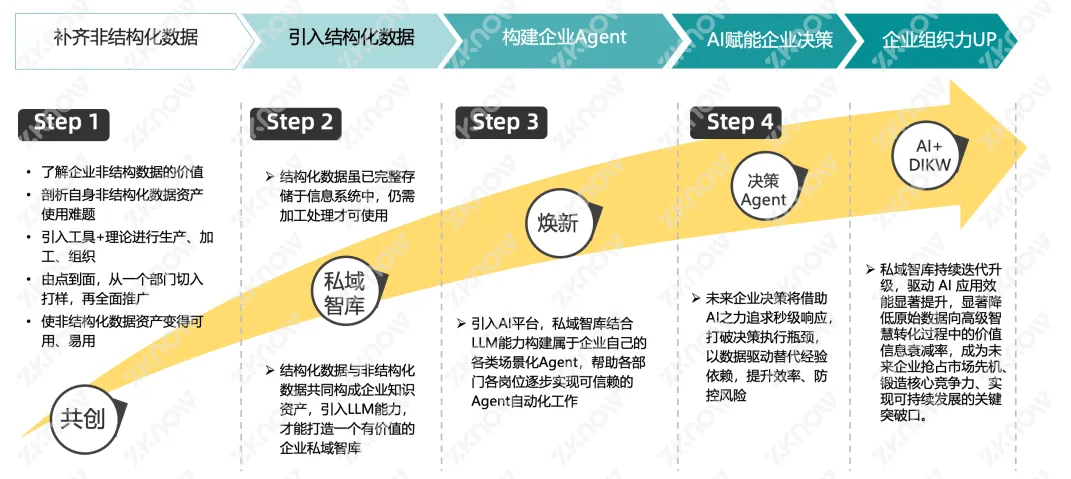Telephone consultation
Get free trial
400-800-2077
Telephone consultation
Online customer service instant communication
Answers to your questions
Online Customer Service
WeChat consultation
Providing you with professional services

Add WeChat customer service
Convenient service
Zhenzhi solution experts will help you
Provide precise solutions
Professional consultation
 Home > News Center > Industry News > Keywords for corporate evolution in 2025: Co-create a private domain think tank and revitalize organizational capabilities!
Home > News Center > Industry News > Keywords for corporate evolution in 2025: Co-create a private domain think tank and revitalize organizational capabilities! The three pillars of AI technology are computing power, algorithms, and data. Of these three core elements, most companies only have control over data. This includes structured data, such as data stored in various enterprise information systems, as well as unstructured data such as text, images, and voice. Currently, a mainstream view in the AI field holds that the core competitive advantage of companies in the AI era lies in high-quality private data. Companies with high-quality private data possess competitive advantages and are expected to stand out in the market; otherwise, competitors may exploit this opportunity to seize the upper hand.
In this process, "co-creation" is crucial. Much data exists in unstructured form, embedded in human experience and scattered across various documents and manuals. It's difficult for companies to extract and consolidate this type of knowledge through administrative directives. Therefore, it's crucial to encourage executive teams, mid-level managers, and top-tier employees to participate in the creation and sharing of knowledge on a single platform. Only then can companies build higher-quality private think tanks.
With the advent of the AI era, we often hear radical terms like "disruption" and "reconstruction." However, from a business development perspective, especially for those with years of experience, leveraging AI to revitalize organizational capabilities is a more pragmatic option. After all, these capabilities and data already belong to the company, and its top employees have always been there.

01 Upgrading opportunities for knowledge management in the AI era
Knowledge Management Model
SECI model: It describes the dynamic transformation process of knowledge in socialization (tacit knowledge to tacit knowledge), externalization (tacit knowledge to explicit knowledge), combination (explicit knowledge to explicit knowledge), and internalization (explicit knowledge to tacit knowledge). This transformation is often hindered in traditional enterprise knowledge management.
The DIKW model presents a hierarchical progression: data is processed into information, then refined into knowledge, and finally sublimated into wisdom. Enterprises are committed to accelerating this transformation to improve decision-making.

DIKW Value Pyramid: How does knowledge transform into wisdom?
Dilemma of Traditional Knowledge Management
It is difficult for humans to perfectly express implicit knowledge, and it is difficult for people to explain their experiences 100% clearly;
There is friction in knowledge sharing within the organization, and knowledge is difficult to flow freely between corporate departments;
Decision makers cannot digest all information in real time because the human brain's ability to process information is limited.
Prospects for the changes brought by AI
Experiences that were once difficult to articulate can now be articulated, making implicit knowledge explicit. AI can automatically capture inexpressible experiences like "feel" and "intuition," transforming them into specific operational parameters and decision-making rules, eliminating the need for human expression.
Departmental walls are broken down, enabling the platformization of knowledge assets. Leveraging AI-powered intelligent knowledge bases, all knowledge is automatically aggregated into the company's private domain database. Experience from all departments is automatically linked and readily accessible, eliminating the need for meetings or file transfers to share knowledge.
Decision-making is no longer based on intuition; it is now intelligent. AI can analyze massive amounts of data in real time, directly delivering useful knowledge to decision makers. It can even predict the consequences of different choices, making decisions faster and more accurate.
02 Knowledge assetization: from transformation to value realization
With AI driving changes in knowledge management, knowledge assetization has become a key direction for enterprises to further tap into the value of knowledge. Knowledge assetization transforms a company's knowledge from a potential, dispersed resource into a measurable, manageable asset with clear value. The process of knowledge assetization is essentially the systematic organization, integration, storage, and application of knowledge.
So, how to measure the effectiveness of knowledge assetization? Here we introduce an important formula: knowledge monetization rate = (call frequency × reuse value) / sedimentation cost.

1. How to increase the frequency of knowledge access?
Obstacle: Knowledge retrieval is difficult. Employees don't know where knowledge is stored and frequently switch systems to search. It's difficult to accurately describe problems, resulting in low retrieval efficiency.
Solution: Make knowledge acquisition more convenient through diversified channels and intelligent means.
1. Provide multi-channel knowledge access to meet the needs of different scenarios;
2. Integrate and embed employees' commonly used platforms to reduce system switching;
3. Build a one-stop AI self-service Q&A platform to quickly respond to questions;
4. Equipped with a full-process AI service assistant to assist in knowledge acquisition throughout the process;
5. Support multi-form questioning and multi-form knowledge matching;
6. Realize cross-language retrieval and response of foreign documents, breaking down language barriers.
2. How to improve the reuse value of knowledge?
Obstacles: Knowledge is fragmented and spread across multiple pieces of data, resulting in low value density. Employees find it difficult to fully obtain the information they need, and knowledge cannot be fully utilized.
Solution: Leverage AI technology to increase knowledge value density and promote knowledge reuse and value-added.
1. Realize intelligent recommendations based on AI vector technology and accurately push relevant knowledge;
2. Create exclusive AI Q&A agents for different private domain knowledge to provide personalized services;
3. Connect with data systems to create agents that fit business scenarios;
4. The bill of lading automatically introduces multi-party knowledge diagnosis work orders to assist in problem solving;
5. Identify duplicate work orders, learn from historical experience, and avoid duplication of work;
6. Use accumulated knowledge to provide all-round support for solutions.
3. How to reduce the sedimentation cost of knowledge?
Obstacles: In daily operations, knowledge often resides in employees' minds, making it difficult to effectively consolidate. Traditional campaign-style knowledge organization lacks sustainability and is difficult to implement.
Solution: Lower the threshold for knowledge output, stimulate employee co-creation, and achieve efficient knowledge accumulation.
1. One-click access to human experience to quickly fill in the gaps in the knowledge tank;
2. The service desk produces solutions while completing knowledge co-creation;
3. Automatically summarize conversation records and extract valuable knowledge;
4. Extract and summarize knowledge from call records through speech recognition technology;
5. Support multimodal knowledge processing, covering text, voice, pictures, etc.;
6. Establish an incentive mechanism to encourage all employees to participate in knowledge sharing.
03 Path to Upgrading Enterprise Organizational Capacity

Step 1: Fill in the unstructured data
Keywords: co-creation
Understand the value of unstructured enterprise data
Analyze the difficulties in using your own unstructured data assets
Introducing tools + theory for production, processing and organization
From point to surface, start with proofing from one department and then promote it comprehensively
Make unstructured data assets available and easy to use
Step 2: Introducing structured data
Keywords: Private Domain Think Tank
Although structured data has been completely stored in the information system, it still needs to be processed before it can be used.
Structured data and unstructured data together constitute the knowledge assets of an enterprise. Only by introducing LLM capabilities can a valuable enterprise private domain think tank be created.
Step 3: Build an Enterprise Agent
Keywords: Renewal
By introducing AI platforms, private domain think tanks combined with LLM capabilities build various scenario-based agents belonging to the enterprise, helping various departments and positions gradually realize reliable agent automation work.
Step 4: AI empowers enterprise decision-making
Keywords: Decision-making Agent
In the future, corporate decision-making will leverage the power of AI to achieve second-level responses, break through the bottleneck of decision execution, replace experience-based decision-making with data-driven decision-making, improve efficiency, and prevent and control risks.
Step 5: Improve corporate organizational capabilities
Keywords: AI+DIKW
The continuous iteration and upgrading of private domain think tanks has significantly improved the efficiency of AI applications and reduced the value information decay rate in the process of converting raw data into advanced intelligence, becoming a key breakthrough for future enterprises to seize market opportunities, forge core competitiveness, and achieve sustainable development.
The gap between future enterprises lies in:
Is AI used to manage knowledge?
Have you built your own knowledge base?
Will experience be turned into a reusable asset?
As the core carrier of knowledge asset accumulation, enterprises should pay attention to the impact of private domain think tanks on corporate development and attach importance to and build them as early as possible.
Zhenzhi Technology has been deeply engaged in digital transformation services for medium and large enterprises for many years. If you are interested in today's sharing topics such as AI knowledge base, we sincerely invite you to discuss and exchange ideas.
Click here to schedule a demo
Hotline: 400-800-2077
